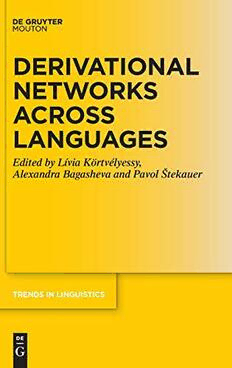
Derivational Networks Across Languages PDF
Preview Derivational Networks Across Languages
LíviaKörtvélyessy,AlexandraBagasheva,PavolŠtekauer(Eds.) DerivationalNetworksAcrossLanguages Trends in Linguistics Studies and Monographs Editors ChiaraGianollo DaniëlVanOlmen Editorial Board WalterBisang TineBreban VolkerGast HansHenrichHock KarenLahousse NataliaLevshina CaterinaMauri HeikoNarrog SalvadorPons NiinaNingZhang AmirZeldes Editor responsible for this volume ChiaraGianollo Volume 340 Derivational Networks Across Languages Edited by Lívia Körtvélyessy Alexandra Bagasheva Pavol Štekauer ISBN978-3-11-068649-4 e-ISBN(PDF)978-3-11-068663-0 e-ISBN(EPUB)978-3-11-068680-7 LibraryofCongressControlNumber:2020931489 BibliographicinformationpublishedbytheDeutscheNationalbibliothek TheDeutscheNationalbibliothekliststhispublicationintheDeutscheNationalbibliografie; detailedbibliographicdataareavailableontheInternetathttp://dnb.dnb.de. ©2020WalterdeGruyterGmbH,Berlin/Boston Typesetting:IntegraSoftwareServicesPvt.Ltd. Printingandbinding:CPIbooksGmbH,Leck www.degruyter.com Preface Thismonographexamines derivational networksin 40European languages.It combines a new theoretical perspective on the complexity of derivational pro- cessesinvariouslanguageswithanexaminationoftheirtypologicalcharacter- istics.Forthatpurpose,anewmethodologicalapproachhasbeenintroduced, including a number of parameters: the saturation value, the maximumderi- vationalcapacity,themaximumandaveragenumberofordersofderivation, andtypicalcombinationsofsemanticcategoriesandtheirblockingeffects. Thepointofdepartureforthetheoreticalconsiderationsistheconceptofthe derivational paradigm that derives from the established concept of the inflec- tionalparadigm.Recentdecadeswitnesstothefactthattheoriginalbiasagainst derivational paradigms has been overcome and that this concept has already found its firm place in morphological investigations. Nevertheless, it appears thatthismonodimensionalconceptcannotprovideuswithacomprehensivepic- tureofthecomplexityanddiversityofderivationalrelations.Thisobservationis reflectedintherelevantliteratureintheuseofabidimensionalconceptofderi- vational nest or family. Still, this level of description is not sufficient either be- cause it disregards the semantic aspect of derivational relations. Therefore, in thisbook,weintroduceatridimensionalsystemofaderivationalnetworkthat– in capturing the complexity of derivational relations – combines the ‘vertical’, paradigmaticdimension(alldirectderivativesfromabaseword),the‘horizontal’ dimension(allsuccessive,linearderivativesfromabaseword),andthesemantic dimension(semanticcategoriesdefiningeachderivationalstep). Typologically,theresearchaimstoidentifythesystematicityandregularity indevelopingderivationalnetworksintheexaminedsampleoflanguagesand inindividuallanguagegeneraand/orfamilies.Thisissupportedbyconsidera- tions about the role of word-classes, morphological types, and the differences andsimilaritiesbetweenword-formationsystemsofthelanguagesbelongingto thesamegenus/family. Wewishtoexpressourthankstothedozensofmorphologistswhorepresent the sample languages in the individual language-specific chapters. This mono- graphwouldnothavecomeintoexistencewithouttheirexpertiseandextensive cooperation. As a result, we can provide a picture of derivational networks in Note:ThisresearchhasbeenimplementedwithfinanncialsupportfromtheVEGA1/0002/17 research grant, and partly also from the Spanish State Research Agency (SRA, Ministry of Economy and Enterprise) and European Regional Development Fund (ERDF) (Ref. FFI2017- 89665-P). https://doi.org/10.1515/9783110686630-202 VI Preface individual languages, language genera, and European languages as a whole (withthelimitationsstemmingfromthesampleoflanguages). Thevolumedoesnotandcannotprovideacompletepictureofthistopicin spiteofitswidescope.However,itintroducesamethodthatcanbeappliedto otherlanguagesandothersamplewordsselectedbyothercriteria,forexample, lexicalfields. Contents Preface V Abbreviations XI LíviaKörtvélyessy,AlexandraBagasheva,PavolŠtekauer, SalvadorValera 1 Introduction 1 MartinaIvanová,BoženaBednaříková 2 IntroductiontoSlaviclanguages 27 AlexandraBagasheva 3 DerivationalnetworksinBulgarian 33 ZrinkaJelaska,TomislavaBošnjakBotica 4 DerivationalnetworksinCroatian 43 BoženaBednaříková 5 DerivationalnetworksinCzech 53 EwaKonieczna 6 DerivationalnetworksinPolish 65 ViacheslavShevchenko,SlávkaTomaščíková 7 DerivationalnetworksinRussian 75 GordanaŠtasni,GordanaŠtrbac 8 DerivationalnetworksinSerbian 85 MartinaIvanová 9 DerivationalnetworksinSlovak 93 KatjaPlemenitaš,InesVoršič,IrenaStramljičBreznik 10 DerivationalnetworksinSlovene 105 NadiaYesypenko 11 DerivationalnetworksinUkrainian 115 VIII Contents GeriPopova,MariaRosenberg 12 IntroductiontoGermaniclanguages 127 HansGötzsche 13 DerivationalnetworksinDanish 129 JackHoeksema 14 DerivationalnetworksinDutch 137 GerganaPopova 15 DerivationalnetworksinEnglish 147 SiebrenDyk 16 DerivationalnetworksinFrisian 157 MartinNeef,AyşeYurdakul 17 DerivationalnetworksinGerman 167 ThorsteinnG.Indridason 18 DerivationalnetworksinIcelandic 179 JohnOleAskedal 19 DerivationalnetworksinNorwegian 189 MariaRosenberg 20 DerivationalnetworksinSwedish 203 LivioGaeta 21 IntroductiontoRomancelanguages 213 ElisendaBernal,MercèLorente 22 DerivationalnetworksinCatalan 217 VincentRenner 23 DerivationalnetworksinFrench 229 MaríaBelénVillarDíaz 24 DerivationalnetworksinGalician 239 Contents IX LivioGaeta 25 DerivationalnetworksinItalian 251 AlinaVillalva 26 DerivationalnetworksinPortuguese 261 CarmenMîrzeaVasile 27 DerivationalnetworksinRomanian 273 AnaDíaz-Negrillo 28 DerivationalnetworksinSpanish 285 MariaBloch-Trojnar,SilvaNurmio 29 IntroductiontoCelticlanguages 295 MariaBloch-Trojnar 30 DerivationalnetworksinIrish 299 SilvaNurmio 31 DerivationalnetworksinWelsh 309 JurgisPakerys 32 IntroductiontoBalticlanguages 319 AgnėNavickaitė-Klišauskienė 33 DerivationalnetworksinLatvian 323 JurgisPakerys 34 DerivationalnetworksinLithuanian 333 DimitraMelissaropoulou,AngelaRalli 35 DerivationalnetworksinGreek 347 LászlóPalágyi,ErzsébetTóth-Czifra,RékaBenczes 36 IntroductiontoUraliclanguages 361 ReetKasik 37 DerivationalnetworksinEstonian 365 X Contents KaarinaPitkänen-Heikkilä 38 DerivationalnetworksinFinnish 373 LászlóPalágyi,ErzsébetTóth-Czifra,RékaBenczes 39 DerivationalnetworksinHungarian 385 KaarinaVuolab-Lohi 40 DerivationalnetworksinNorthSaami 399 AslıGöksel 41 IntroductiontoTatarandTurkish 409 LászlóKároly 42 DerivationalnetworksinTatar 411 AslıGöksel,AyselKapan 43 DerivationalnetworksinTurkish 423 SedaYusupova 44 DerivationalnetworksinChechen 435 NinaSumbatova 45 DerivationalnetworksinDargwa 443 XabierArtiagoitia 46 DerivationalnetworksinBasque 455 MananaTopadzeGäumann 47 DerivationalnetworksinGeorgian 465 BenjaminSaade 48 DerivationalnetworksinMaltese 475 LíviaKörtvélyessy,AlexandraBagasheva,PavolŠtekauer, SalvadorValera,JánGenči 49 DerivationalnetworksinEuropeanlanguages: Across-linguisticperspective 485 Index 609
